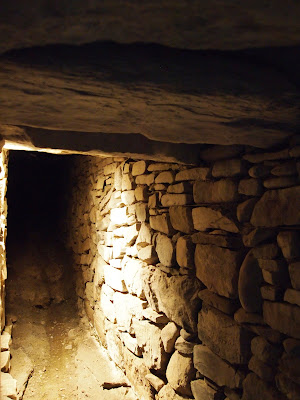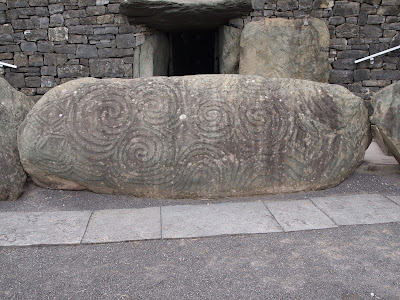The two sites are part of a larger complex around the Boyne River that includes 3 large passage mounds (Newgrange, Knowth, and Dowth) and more than 20 much smaller mounds. Dowth isn't open to the public due to safety issues. Some of the smaller ones haven't been excavated at all. They are just dotted through the surrounding area in middle of working fields- a small hill of un-mown grass encircled by cows or sheared wheat.
Access to the mounds is strictly regulated. You can't go by yourself, you must go on a guided tour and be bused in from the visitor's center. Around 2000 people show up on a good day, and only 750 are allowed to go to the mounds themselves. Needless to say, we made an effort to get there early, but since it was so cold, we didn't have to worry.
We went to Knowth first. I was sure that, even though it was the lesser known site, it would be more impressive. In addition to the large mound, it has at least 18 satellite mounds and many decorated stones. And it was pretty amazing.
Knowth was in use for thousands of years, first as a Neolithic burial mound and likely ritual mound. Its passages probably line up so that the sun shines in during the equinoxes. (don't ask about the "probably.") It is suspected that the original builders were attempting to create a permanent home for the ancestor spirits, or gods, or both, but for obvious reasons no-one can be sure. We were allowed inside the mound, but only into a room off to the side, that had been constructed during excavation. I took the photo to the left through a gate while going past. It's of the passage leading into the burial chamber. It's the same passage as the first photo in this post, but some kid used his camera with an enormous flash while I took this one. It's rather less evocative but more detailed, so I'm including it.
What was most arresting for me at Knowth was the megalithic art work on the stones surrounding the mound. No-one knows for sure what it means, but I just can't get over the fact that it was chiseled into those stones 5000 years ago, by people honoring some movement of the spirit that we will probably never know.
Most of the stone in the mounds was brought in, often from considerable distance. It would have taken 80 men 4 days to haul each of the larger stones up from the river, and that doesn't include the time collecting it and floating it up the river. They estimate it would have taken two generations to build each of the larger mounds.
What kind of vision were they fulfilling? While UU's are big on "live the questions," I myself have never been particularly gifted in that regard. I really, really, really want to know.
And the thing is, they rush you through the site. We had an hour total there, about 10 min. of which was movement to and from the bus and 30 min of which was a guided tour. Not too much time to "sit with the mystery," as it were.
So I left curious and awe-inspired but not feeling overly....moved.
After a quick pop back to the visitor's center (which is beautifully done, by the way), we headed off for a tour of Newgrange.
Newgrange is a larger mound than Knowth and in better shape. It's famous for its white front wall, which is an archeologist's best guess at how it would have looked originally. The stone is, in fact, the original stone, but it had all fallen by modern times. He used "reverse engineering" to construct the wall. (Greg, please explain to me!)
Newgrange also has the most famous decorated stone of all the sites- its doorway stone.
The triple spiral is repeated inside and is the best known of all the patterns. But again, what it means is anyone's guess- a map of the land, sky, spirit world.....
We were allowed to go inside the mound in small groups, this time all the way to the burial chamber. And this time, my breath caught as we eased in through the very narrow passage way and into the small inner chamber. Moving deeper and deeper into the mound, squeezing and ducking to get through, was a very visceral experience. And everything in the chamber was untouched (except by Victorian era graffiti artists, and the recent addition of small, discrete electric lights and a few safety barriers). The roof, constructed of enormous stones layered upon each other and gradually stepping inward, was as it was 5000 years ago. The burial stones, gently shaped to hold a body, were where they had always been. Those strange symbols, carved with mysterious and powerful intent, were still there, calling out to the world of the spirit.
For just a moment, they turned off the power and a small beam of light (from the guide) crept across the floor, as it does on the winter solstice.
Words are generally the worst medium to convey religious experience, so I'll just say that for a brief moment, I felt connected with that mystery.
And it was almost enough.











Neat stuff! Reverse engineering ... Did he look through a mirror?
ReplyDelete